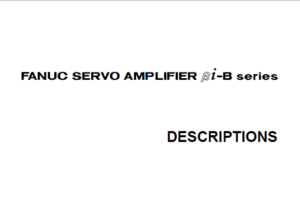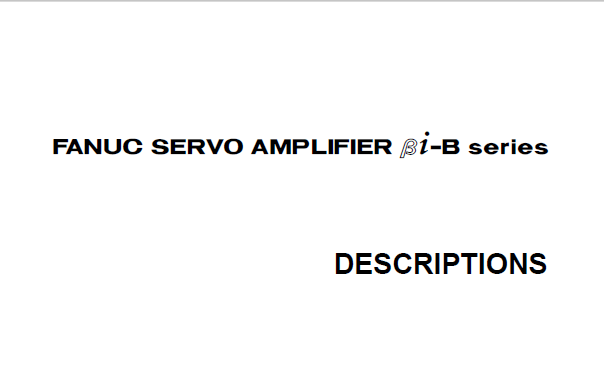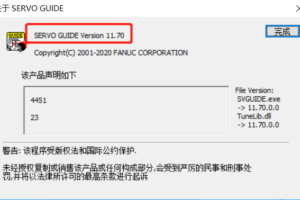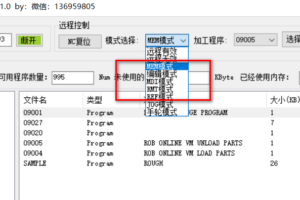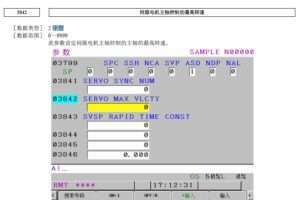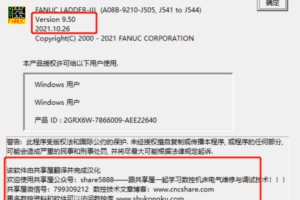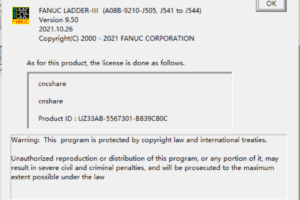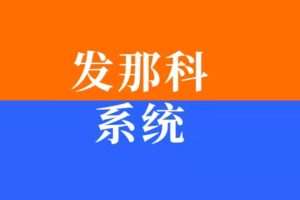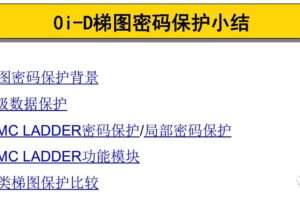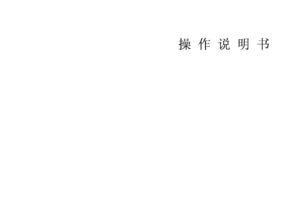B-65422EN_βi-B 伺服放大器 规格_英文_v02_04
本手册是FANUC 最新的-B规格的伺服放大器资料。书号为:B-65422EN_βi-B
该手册为英文手册,书的目录可以在本篇文章中查到,具体详细内容,请下载查看
说明书目录如下:
SAFETY PRECAUTIONS………………………………………………………………….s-1
DEFINITION OF WARNING, CAUTION, AND NOTE ……………………………………… s-1
WARNINGS AND CAUTIONS RELATING TO MOUNTING …………………………….. s-2
Warning ……………………………………………………………………………………………………………….s-2
Caution ……………………………………………………………………………………………………………….s-3
Note ……………………………………………………………………………………………………………….s-4
WARNINGS AND CAUTIONS RELATING TO A PILOT RUN ………………………….. s-4
Warning ……………………………………………………………………………………………………………….s-4
Caution ……………………………………………………………………………………………………………….s-5
WARNINGS AND CAUTIONS RELATING TO MAINTENANCE……………………….. s-6
Warning ……………………………………………………………………………………………………………….s-6
Caution ……………………………………………………………………………………………………………….s-7
Note ……………………………………………………………………………………………………………….s-7
I. iSV-B
1 OVERVIEW …………………………………………………………………………………3
1.1 ABOUT THE NAME…………………………………………………………………………… 3
1.2 FEATURE…………………………………………………………………………………………4
1.3 NOTES ……………………………………………………………………………………………. 4
2 CONFIGURATION ……………………………………………………………………….5
2.1 iSV4-B AND iSV20-B …………………………………………………………………….. 5
2.2 iSV40-B AND iSV80-B……………………………………………………………………. 7
2.3 iSV10HV-B, iSV20HV-B, AND iSV40HV-B…………………………………….. 9
2.4 iSV20/20-B AND iSV40/40-B…………………………………………………………. 11
3 SPECIFICATIONS………………………………………………………………………13
3.1 INPUT POWER ………………………………………………………………………………. 13
3.1.1 Power Supply of 200-V Input Series (Three-phase Input)……………………………….13
3.1.2 Power Supply of 200-V Input Series (Single-phase Input) ………………………………23
3.1.3 Power Supply of 400-V Input Series (Three-phase Input)……………………………….24
3.1.4 Control Power Supply ………………………………………………………………………………..34
3.2 ENVIRONMENTAL CONDITIONS …………………………………………………….. 38
3.3 SPECIFICATIONS…………………………………………………………………………… 43
3.4 APPLICABLE MOTORS…………………………………………………………………… 46
4 ORDERING INFORMATION ………………………………………………………..50
4.1 SERVO AMPLIFIER ………………………………………………………………………… 50
4.2 CIRCUIT BREAKER………………………………………………………………………… 50
4.3 MAGNETIC CONTACTOR……………………………………………………………….. 52
4.4 AC LINE FILTER …………………………………………………………………………….. 53
4.5 LIGHTNING SURGE PROTECTOR…………………………………………………… 55
4.6 NOISE FILTER ……………………………………………………………………………….. 55
4.7 BATTERY FOR ABSOLUTE PULSECODER………………………………………. 56
4.8 SEPARATED COOLING FAN MOTOR………………………………………………. 57
4.8.1 Models Requiring Separated Cooling Fan Motors………………………………………….57
4.8.2 Installing a Separated Cooling Fan Motor……………………………………………………..57
5 HOW TO SELECT THE AMPLIFIER …………………………………………….58
5.1 SELECTING A SEPARATED REGENERATIVE DISCHARGE RESISTOR 58
5.1.1 When Amplifier Models iSV4-B and iSV20-B Are Used ……………………………58
5.1.2 When Amplifier Models iSV40-B and iSV80-B Are Used ………………………….61
5.1.3 When Amplifier Models iSV10HV-B, iSV20HV-B, and iSV40HV-B Are Used
……………………………………………………………………………………………………………….62
5.1.4 When Amplifier Models iSV20/20-B and iSV40/40-B Are Used…………………63
5.1.5 Cautions for Installing a Separated Regenerative Discharge Resistor ……………….65
6 INSTALLATION …………………………………………………………………………72
6.1 LEAKAGE CURRENT ……………………………………………………………………… 72
6.2 GROUND………………………………………………………………………………………..73
6.2.1 Ground Systems ………………………………………………………………………………………..73
6.2.2 Grounding Method …………………………………………………………………………………….74
6.2.3 Notes on Connecting ………………………………………………………………………………….76
6.3 NOISE PREVENTION ……………………………………………………………………… 76
6.3.1 Separation of Signal Lines ………………………………………………………………………….76
6.3.2 Cable Clamp and Shield Processing……………………………………………………………..77
6.3.3 Cabinet …………………………………………………………………………………………………….80
6.3.4 Others ………………………………………………………………………………………………………81
6.4 FITTING A LIGHTNING SURGE PROTECTION DEVICE (POWER SUPPLY
OF 200-VAC INPUT SERIES) ……………………………………………………………82
6.5 AMPLIFIER INSTALLATION NOTES RELATING TO SAFETY STANDARDS
……………………………………………………………………………………………………… 82
6.5.1 Requirements of EN and IEC Standards ……………………………………………………….82
6.5.1.1 Classification in standards on insulation design ………………………………………… 82
6.5.1.2 Protection against electric shock……………………………………………………………… 83
6.5.1.3 Protective grounding………………………………………………………………………………84
6.5.1.4 EMC……………………………………………………………………………………………………. 84
6.5.1.5 Notes on the emergency stop circuit configuration ……………………………………. 84
6.5.1.6 Reduction of load ratio to ambient temperature ………………………………………… 85
6.5.1.7 Overload protection ……………………………………………………………………………….85
6.5.1.8 External overload protection device ………………………………………………………… 85
6.5.1.9 Over-speed protection…………………………………………………………………………….85
6.5.1.10 24-V power supply ……………………………………………………………………………….. 85
6.5.1.11 Screw tightening torque…………………………………………………………………………. 85
6.5.2 Requirements of UL Standards ……………………………………………………………………86
6.5.2.1 Classification in standards on insulation design ………………………………………… 86
6.5.2.2 Protection against electric shock……………………………………………………………… 86
6.5.2.3 Protective grounding………………………………………………………………………………87
6.5.2.4 Overload protection ……………………………………………………………………………….87
6.5.2.5 External overload protection device ………………………………………………………… 87
6.5.2.6 Short-circuit protection…………………………………………………………………………..87
6.5.2.7 Over-speed protection…………………………………………………………………………….87
6.5.2.8 24-V power supply ……………………………………………………………………………….. 87
6.5.2.9 Screw tightening torque…………………………………………………………………………. 87
6.6 NOTES ON CUTTING FLUID (REFERENCE) …………………………………….. 88
7 POWER FAILURE DETECTION FUNCTION …………………………………89
7.1 POWER FAILURE DETECTION FUNCTION………………………………………. 89
8 EXTERNAL DIMENSIONS / PANEL CUT-OUT DRAWINGS /
MAINTENANCE AREA……………………………………………………………….90
8.1 EXTERNAL DIMENSIONS ……………………………………………………………….. 90
8.1.1 External Dimensions of iSV4-B and iSV20-B……………………………………………90
8.1.2 External Dimensions of iSV40-B, iSV80-B, iSV10HV-B, iSV20HV-B, and
iSV40HV-B…………………………………………………………………………………………….91
8.1.3 External Dimensions of iSV20/20-B and iSV40/40-B ………………………………..92
8.1.4 External Dimensions of Separated Cooling Fan Motor (A06B-6134-K002)………94
8.1.5 External Dimensions of Separated Cooling Fan Motor (A06B-6134-K005)………95
8.1.6 Separated Regenerative Discharge Resistor …………………………………………………..96
8.1.7 AC Line Filter …………………………………………………………………………………………101
8.1.8 Battery Case ……………………………………………………………………………………………103
8.1.9 Circuit Breaker ………………………………………………………………………………………..103
8.1.10 Magnetic Contactors…………………………………………………………………………………104
8.1.11 Lightning Surge Protector …………………………………………………………………………105
8.1.12 Noise Filter ……………………………………………………………………………………………..106
8.2 PANEL CUT-OUT………………………………………………………………………….. 108
8.2.1 iSV4-B and iSV20-B ……………………………………………………………………………108
8.2.2 iSV40-B, iSV80-B, iSV10HV-B, iSV20HV-B, and iSV40HV-B ………109
8.2.3 iSV20/20-B and iSV40/40-B …………………………………………………………………110
8.2.4 Separated Regenerative Discharge Resistor …………………………………………………111
8.3 MAINTENANCE AREA…………………………………………………………………… 114
8.3.1 Maintenance Area for the iSV4-B and iSV20-B……………………………………….114
8.3.2 Maintenance Area for the iSV40-B, iSV80-B, iSV10HV-B, iSV20HV-B, and
iSV40HV-B…………………………………………………………………………………………..115
8.3.3 Maintenance Area for the iSV20/20-B and iSV40/40-B ……………………………117
9 TOTAL CONNECTION DIAGRAM………………………………………………118
9.1 CONNECTION DIAGRAM………………………………………………………………. 118
9.1.1 iSV4-B and iSV20-B ……………………………………………………………………………118
9.1.2 iSV40-B and iSV80-B ………………………………………………………………………….120
9.1.3 iSV10HV-B, iSV20HV-B, and iSV40HV-B…………………………………………122
9.1.4 iSV20/20-B and iSV40/40-B …………………………………………………………………124
9.2 CONNECTOR LOCATION ……………………………………………………………… 126
9.2.1 iSV4-B and iSV20-B ……………………………………………………………………………126
9.2.2 iSV40-B, iSV80-B, iSV10HV-B, iSV20HV-B, and iSV40HV-B ………127
9.2.3 iSV20/20-B …………………………………………………………………………………………..128
9.2.4 iSV40/40-B …………………………………………………………………………………………..129
9.2.5 Connection Tools …………………………………………………………………………………….130
9.2.6 Details of Cable K1 ………………………………………………………………………………….131
9.2.6.1 iS-B and iF-B series servo motors, iS-B (iS0.4/5000-B to iS40/2000-B),
iSc-B, and iF-B series servo motors…………………………………………………… 131
9.2.6.2 iS series servo motors (iS0.2/5000 and iS0.3/5000) …………………………… 133
9.2.7 Details of Cable K2 ………………………………………………………………………………….135
9.2.7.1 Details of connectors …………………………………………………………………………… 135
9.2.7.2 Selecting cables (general) …………………………………………………………………….. 137
9.2.8 Details of Cable K3 ………………………………………………………………………………….139
9.2.8.1 Details of connectors …………………………………………………………………………… 139
9.2.8.2 Details of cables (general) ……………………………………………………………………. 141
9.2.9 Details of Cables K4 and K5 ……………………………………………………………………..143
9.2.9.1 iSV4-B and iSV20-B……………………………………………………………………….. 143
9.2.9.2 iSV40-B and iSV80-B……………………………………………………………………… 145
9.2.9.3 iSV10HV-B, iSV20HV-B, and iSV40HV-B……………………………………. 148
9.2.9.4 iSV20/20-B and iSV40/40-B ……………………………………………………………. 150
9.2.10 Details of Cable K6 ………………………………………………………………………………….154
9.2.11 Details of Cable K7 ………………………………………………………………………………….155
9.2.12 Details of Cable K8 ………………………………………………………………………………….156
9.2.13 Details of Cable K9 ………………………………………………………………………………….158
9.2.14 Details of Cable K10 ………………………………………………………………………………..159
9.2.15 Details of Cable K11 ………………………………………………………………………………..162
9.2.16 Details of Cable K12 ………………………………………………………………………………..163
9.2.17 Details of Cable K13 ………………………………………………………………………………..163
10 HEAT DISSIPATION…………………………………………………………………164
10.1 TOTAL AMOUNT OF HEAT DISSIPATION ………………………………………. 164
10.1.1 iSV-B and iSV HV-B……………………………………………………………………………164
10.1.2 AC Line Filter …………………………………………………………………………………………164
10.2 RESIDUAL AMOUNT OF HEAT IN THE CABINET…………………………….. 165
11 COMBINATIONS OF DIFFERENT MODELS ……………………………….166
11.1 iSV-B(FSSB) AND iSV-B(I/O Link Option)……………………………………… 166
11.2 i-B AMPLIFIER AND iSV-B(FSSB) ………………………………………………. 167
11.3 iSVSP-B AMD iSV-B(FSSB)………………………………………………………… 168
11.4 2-AXIS iSV-B(FSSB) AND iSV-B(FSSB)……………………………………….. 169
II. iSVSP-B
1 OVERVIEW ……………………………………………………………………………..173
1.1 FEATURES OF THE SERVO AMPLIFIER iSVSP-B SERIES…………….. 173
1.2 DIFFERENCES FROM iSVSP……………………………………………………….174
1.3 DIFFERENCES FROM THE SERVO AMPLIFIER i-B SERIES ………….. 176
2 CONFIGURATION ……………………………………………………………………177
2.1 CONFIGURATION…………………………………………………………………………. 177
2.2 SERVO AMPLIFIER iSVSP-B SERIES…………………………………………… 179
3 SPECIFICATIONS…………………………………………………………………….181
3.1 INPUT POWER …………………………………………………………………………….. 181
3.1.1 Power Supply of 200-V/400-V Input Series (Three-phase Input)……………………181
3.1.2 Control Power Supply ………………………………………………………………………………192
3.2 ENVIRONMENTAL CONDITIONS …………………………………………………… 195
3.3 SPECIFICATIONS…………………………………………………………………………. 197
3.4 APPLICABLE MOTORS…………………………………………………………………. 204
3.5 DYNAMIC BRAKE………………………………………………………………………….214
3.6 SPINDLE AXIS TYPES AND APPLICABLE SENSORS………………………. 217
3.7 HOW TO OBTAIN A POWER SUPPLY CAPACITY……………………………. 220
4 ORDERING INFORMATION ………………………………………………………221
4.1 SERVO AMPLIFIER iSVSP-B SERIES…………………………………………… 221
4.1.1 200-V Input Series……………………………………………………………………………………221
4.1.2 400-V Input Series……………………………………………………………………………………221
4.2 Other……………………………………………………………………………………………. 222
4.2.1 AC Reactor ……………………………………………………………………………………………..222
4.2.2 Connectors………………………………………………………………………………………………222
4.2.3 Fuses………………………………………………………………………………………………………227
4.2.4 Cables…………………………………………………………………………………………………….228
4.2.5 Circuit Breaker and Magnetic Contactor……………………………………………………..229
4.2.6 Lightning Surge Protector …………………………………………………………………………231
4.2.7 Noise Filter ……………………………………………………………………………………………..231
4.2.8 Sensors for Servo……………………………………………………………………………………..232
4.2.9 Sensors for Spindle…………………………………………………………………………………..232
4.2.10 Power Line Switch Unit ……………………………………………………………………………233
4.2.11 Submodule SW………………………………………………………………………………………..234
4.2.12 Battery for Absolute Pulsecoder…………………………………………………………………234
4.2.13 24-V Power Supply Unit …………………………………………………………………………..235
5 INSTALLATION ……………………………………………………………………….236
5.1 LEAKAGE CURRENT ……………………………………………………………………. 236
5.2 GROUND………………………………………………………………………………………236
5.2.1 Ground Systems ………………………………………………………………………………………236
5.2.2 Grounding Method …………………………………………………………………………………..237
5.2.3 Notes on Connecting ………………………………………………………………………………..239
5.3 NOISE PREVENTION ……………………………………………………………………. 239
5.3.1 Separation of Signal Lines ………………………………………………………………………..239
5.3.2 Cable Clamp and Shield Processing……………………………………………………………240
5.3.3 Cabinet …………………………………………………………………………………………………..243
5.3.4 Others …………………………………………………………………………………………………….244
5.4 AMPLIFIER INSTALLATION NOTES RELATING TO SAFETY STANDARDS
……………………………………………………………………………………………………. 245
5.4.1 Requirements of EN and IEC Standards ……………………………………………………..245
5.4.1.1 Classification in standards on insulation design ………………………………………. 245
5.4.1.2 Protection against electric shock……………………………………………………………. 246
5.4.1.3 Protective grounding…………………………………………………………………………….247
5.4.1.4 EMC………………………………………………………………………………………………….. 247
5.4.1.5 Notes on the emergency stop circuit configuration ………………………………….. 247
5.4.1.6 Reduction of load ratio to ambient temperature ………………………………………. 247
5.4.1.7 Overload protection ……………………………………………………………………………..248
5.4.1.8 External overload protection device ………………………………………………………. 248
5.4.1.9 Over-speed protection…………………………………………………………………………..248
5.4.1.10 Screw tightening torque……………………………………………………………………….. 248
5.4.2 Requirements of UL Standards ………………………………………………………………….248
5.4.2.1 Classification in standards on insulation design ………………………………………. 248
5.4.2.2 Protection against electric shock……………………………………………………………. 249
5.4.2.3 Protective grounding…………………………………………………………………………….249
5.4.2.4 Overload protection ……………………………………………………………………………..249
5.4.2.5 External overload protection device ………………………………………………………. 249
5.4.2.6 Short-circuit protection…………………………………………………………………………249
5.4.2.7 Over-speed protection…………………………………………………………………………..249
5.4.2.8 Overheat protection ……………………………………………………………………………..250
5.4.2.9 Screw tightening torque……………………………………………………………………….. 250
5.5 NOTES ON COOLANT (REFERENCE) …………………………………………….250
6 EXTERNAL DIMENSIONS AND MAINTENANCE AREA ………………251
6.1 EXTERNAL DIMENSIONS ……………………………………………………………… 251
6.1.1 Servo Amplifier iSVSP-B Series ……………………………………………………………..251
6.1.2 AC Reactor ……………………………………………………………………………………………..253
6.1.3 Circuit Breaker ………………………………………………………………………………………..255
6.1.4 Magnetic Contactor ………………………………………………………………………………….256
6.1.5 Lightning Surge Protector …………………………………………………………………………260
6.1.6 Noise Filter ……………………………………………………………………………………………..261
6.1.7 24-V Power Supply Unit …………………………………………………………………………..264
6.1.8 Battery Case ……………………………………………………………………………………………267
6.2 PANEL CUT-OUT………………………………………………………………………….. 268
6.3 MAINTENANCE AREA…………………………………………………………………… 270
7 CONNECTION………………………………………………………………………….272
7.1 TOTAL CONNECTION DIAGRAM …………………………………………………… 272
7.2 CONNECTOR LOCATION ……………………………………………………………… 272
7.3 CABLE CONNECTION DETAILS…………………………………………………….. 274
7.3.1 Common …………………………………………………………………………………………………278
7.3.1.1 Details of cable K1 ……………………………………………………………………………… 278
7.3.1.2 Short bar K2……………………………………………………………………………………….. 278
7.3.1.3 Details of cable K6 ……………………………………………………………………………… 280
7.3.1.4 Details of cable K7 ……………………………………………………………………………… 282
7.3.1.5 Details of cable K69 ……………………………………………………………………………. 283
7.3.1.6 Details of cable K105 ………………………………………………………………………….. 284
7.3.1.7 Details of cable K73,K74 …………………………………………………………………….. 285
7.3.1.8 Details of cable K124 ………………………………………………………………………….. 286
7.3.1.9 Details of cable K70 ……………………………………………………………………………. 289
7.3.1.10 Details of cable K77 ……………………………………………………………………………. 290
7.3.2 Servo Motor…………………………………………………………………………………………….291
7.3.2.1 Details of cable K21 ……………………………………………………………………………. 292
7.3.2.2 Details of cable K22 ……………………………………………………………………………. 292
7.3.2.3 Details of cable K27 ……………………………………………………………………………. 293
7.3.2.4 Details of cable K28 ……………………………………………………………………………. 296
7.3.2.5 Details of cable K141 ………………………………………………………………………….. 296
7.3.3 Spindle Motor………………………………………………………………………………………….303
7.3.3.1 Details of cable K10 ……………………………………………………………………………. 303
7.3.3.2 Details of cable K11 ……………………………………………………………………………. 304
7.3.3.3 Details of cable K14 ……………………………………………………………………………. 304
7.3.3.4 Details of cable K16 ……………………………………………………………………………. 304
7.3.3.5 Details of cable K17 ……………………………………………………………………………. 305
7.3.3.6 Details of cable K33 ……………………………………………………………………………. 308
7.3.3.7 Details of cable K71 ……………………………………………………………………………. 312
7.3.3.8 Details of cable K79 ……………………………………………………………………………. 320
7.3.3.9 Details of cable K96 ……………………………………………………………………………. 324
7.3.3.10 Details of cable K97 ……………………………………………………………………………. 326
7.3.3.11 Spindle Motor Feedback Cable Connection ……………………………………………. 327
7.4 DETAILS OF CONNECTORS …………………………………………………………. 328
7.4.1 20-pin Half-pitch Connectors…………………………………………………………………….330
7.4.2 Tyco Electronics AMP D-5000 Series Connector…………………………………………331
8 HEAT DISSIPATION…………………………………………………………………333
8.1 TOTAL AMOUNT OF HEAT DISSIPATION ………………………………………. 333
8.1.1 Servo Amplifier iSVSP-B Series ……………………………………………………………..333
8.1.2 AC Reactor ……………………………………………………………………………………………..337
8.2 RESIDUAL AMOUNT OF HEAT IN THE CABINET…………………………….. 338
9 SERVO AMPLIFIER COOLING CONDITIONS……………………………..342
10 SPINDLE-RELATED OPTIONS………………………………………………….343
10.1 SPINDLE ORIENTATION……………………………………………………………….. 343
10.2 POWER LINE SWITCH CIRCUIT…………………………………………………….. 343
10.2.1 Overview ………………………………………………………………………………………………..343
10.2.2 Switch Circuit Configuration …………………………………………………………………….343
10.2.3 Power Line Switch Unit ……………………………………………………………………………344
10.2.3.1 Specification ………………………………………………………………………………………. 344
10.2.3.2 Outside and Mounting Dimension Diagrams ………………………………………….. 345
10.2.3.3 Connection…………………………………………………………………………………………. 349
10.2.3.4 Notes…………………………………………………………………………………………………. 349
10.3 Sub module SW……………………………………………………………………………..351
10.3.1 Configuration ………………………………………………………………………………………….351
10.3.2 Specifications ………………………………………………………………………………………….352
10.3.3 External Dimensions ………………………………………………………………………………..353
10.3.4 Connector Location ………………………………………………………………………………….355
10.3.5 Connection ……………………………………………………………………………………………..356
11 SENSOR………………………………………………………………………………….357
11.1 SENSOR FOR THE SERVO SYSTEM………………………………………………357
11.1.1 ABSOLUTE iCZ SENSOR (for Separate Detector Use) …………………………….357
11.1.1.1 Specification ………………………………………………………………………………………. 357
11.1.1.2 External dimensions…………………………………………………………………………….. 359
11.2 USAGE OF iCZ SENSOR WITH CONSIDERATION OF ENVIRONMENTAL
RESISTANCE………………………………………………………………………………..360
11.2.1 Overview ………………………………………………………………………………………………..360
11.2.2 Sensor Installation Conditions……………………………………………………………………360
11.2.3 Cable Layout …………………………………………………………………………………………..361
11.2.3.1 Installing the sensor …………………………………………………………………………….. 362
11.2.3.2 Connection…………………………………………………………………………………………. 366
11.2.3.3 Rotation direction ……………………………………………………………………………….. 371
11.2.3.4 Start-up procedure ………………………………………………………………………………. 371
11.2.3.5 Interpolation error compensation…………………………………………………………… 372
11.2.3.6 Function for detecting the disconnection of the Sensor head cable…………….. 372
11.2.3.7 Procedure for initializing the Detection circuit………………………………………… 374
11.2.3.8 Notes on use……………………………………………………………………………………….. 376
11.2.3.9 Output signal check method …………………………………………………………………. 377
11.3 SENSOR FOR THE SPINDLE…………………………………………………………. 379
11.3.1 i POSITIONCODER………………………………………………………………………………379
11.3.1.1 Specification ………………………………………………………………………………………. 379
11.3.1.2 Signal phase relationships (timing chart)………………………………………………… 380
11.3.1.3 External dimensions…………………………………………………………………………….. 380
11.3.1.4 Connection…………………………………………………………………………………………. 381
11.3.1.5 Installation conditions and notes …………………………………………………………… 381
11.3.2 POSITIONCODER S…………………………………………………………………………….382
11.3.2.1 Specification ………………………………………………………………………………………. 382
11.3.2.2 Signal phase relationships (timing chart)………………………………………………… 383
11.3.2.3 External dimensions…………………………………………………………………………….. 383
11.3.2.4 Connection…………………………………………………………………………………………. 384
11.3.2.5 Installation conditions and notes …………………………………………………………… 384
11.3.3 iBZ SENSOR (for Spindle) …………………………………………………………………….386
11.3.3.1 Specification ………………………………………………………………………………………. 386
11.3.3.2 External dimensions…………………………………………………………………………….. 388
11.3.3.3 Interference of the Detection ring………………………………………………………….. 390
11.3.3.4 Installing the sensor …………………………………………………………………………….. 391
11.3.3.5 Connection…………………………………………………………………………………………. 395
11.3.4 Notes on the Detection Ring ……………………………………………………………………..396
11.3.5 Usage with Consideration Of Environmental Resistance……………………………….396
11.3.6 iCZ SENSOR (for Spindle) …………………………………………………………………….398
11.3.6.1 Specification ………………………………………………………………………………………. 398
11.3.6.2 External dimensions…………………………………………………………………………….. 399
11.4 USAGE OF iCZ SENSOR WITH CONSIDERATION OF ENVIRONMENTAL
RESISTANCE………………………………………………………………………………..400
11.4.1 Overview ………………………………………………………………………………………………..400
11.4.2 Sensor Installation Conditions……………………………………………………………………400
11.4.3 Cable Layout …………………………………………………………………………………………..401
11.4.3.1 Installing the sensor …………………………………………………………………………….. 401
11.4.3.2 Connection…………………………………………………………………………………………. 405
11.4.3.3 Rotation direction ……………………………………………………………………………….. 407
11.4.3.4 Start-up procedure ………………………………………………………………………………. 408
11.4.3.5 Interpolation error compensation…………………………………………………………… 408
11.4.3.6 Notes on use……………………………………………………………………………………….. 409
11.4.3.7 Displaying the sensor amplitude and offset information …………………………… 409
11.4.3.8 Maintenance target parts………………………………………………………………………. 410
12 POWER FAILURE DETECTION FUNCTION ……………………………….412
12.1 OVERVIEW ………………………………………………………………………………….. 412
12.2 POWER FAILURE DETECTION CONDITIONS…………………………………. 412
12.3 POWER FAILURE DETECTION SIGNALS……………………………………….. 413
12.3.1 Contact Signal …………………………………………………………………………………………413
12.3.2 PMC Signal …………………………………………………………………………………………….413
12.4 PROTECTION FUNCTIONS USING POWER FAILURE DETECTION
SIGNALS……………………………………………………………………………………… 414
12.4.1 Function for Preventing Vertical Axes from Falling……………………………………..414
12.4.1.1 Procedure…………………………………………………………………………………………… 415
12.4.1.2 Brake circuit ………………………………………………………………………………………. 415
12.4.1.3 Method for keeping vertical axis motors excited……………………………………… 418
12.4.1.4 Cautions …………………………………………………………………………………………….. 419
12.4.1.5 Confirming effect………………………………………………………………………………… 419
12.4.2 Quick Stop Function…………………………………………………………………………………420
12.4.3 Retract Function ………………………………………………………………………………………420
13 SAFE TORQUE OFF FUNCTION ……………………………………………….421
13.1 OVERVIEW ………………………………………………………………………………….. 421
13.2 INPUT/OUTPUT SIGNALS……………………………………………………………… 422
13.2.1 Connector Used for the STO Function………………………………………………………..422
13.2.2 Connector Specification ……………………………………………………………………………422
13.2.3 Input/Output Specifications……………………………………………………………………….423
13.3 USING THE STO FUNCTION …………………………………………………………. 427
13.3.1 Setting the Parameter………………………………………………………………………………..427
13.3.2 Setting a Switch on the Servo Amplifier……………………………………………………..427
13.3.3 Switch SW………………………………………………………………………………………………429
13.4 SV DRIVE OFF CIRCUIT FAILURE ALARM……………………………………… 430
13.4.1 Condition of Alarm ………………………………………………………………………………….430
13.4.2 Troubleshooting an SV Drive OFF Circuit Failure Alarm……………………………..430
13.5 LED DISPLAY………………………………………………………………………………..431
13.6 EXAMPLE OF CONNECTION…………………………………………………………. 432
13.7 REMAINING RISKS……………………………………………………………………….. 433
13.8 OTHER NOTES…………………………………………………………………………….. 433
14 PARAMETERS FOR POWER SUPPLIES……………………………………434
14.1 PROCEDURE FOR SETTING PARAMETERS FOR POWER SUPPLIES 434
14.1.1 Parameters for Power Supplies…………………………………………………………………..434
14.1.2 Procedure for Setting Parameters ……………………………………………………………….435
14.1.3 Action to Be Taken When a Parameter Setting Error Occurs …………………………436
14.1.3.1 Displaying the TROUBLE DGN. MONITOR Screen (CURRENT) ………….. 436
14.1.3.2 Invalid setting parameter identification and resetting……………………………….. 438
14.1.4 Alarms ……………………………………………………………………………………………………440
14.2 PARAMETERS……………………………………………………………………………… 441
14.2.1 Overview of Parameters ……………………………………………………………………………441
14.2.2 Details of Parameters………………………………………………………………………………..442
14.3 CONNECTION RELATIONSHIPS AMONG SERVO AMPLIFIERS……….. 445
14.3.1 PS Control Axis……………………………………………………………………………………….445
14.3.2 Method for Checking the Connection Relationships among Servo Amplifiers …446
14.3.2.1 Displaying TROUBLE DGN. MONITOR (CURRENT)………………………….. 446
14.3.2.2 Checking the connection relationships among amplifiers …………………………. 446
14.4 CHECKING THE SERIES AND EDITION OF POWER SUPPLY SECTION
SOFTWARE …………………………………………………………………………………. 451
15 TROUBLE DIAGNOSIS FUNCTION……………………………………………454
15.1 OVERVIEW ………………………………………………………………………………….. 454
15.2 TROUBLE DIAGNOSIS GUIDANCE…………………………………………………455
15.3 TROUBLE DGN. MONITOR……………………………………………………………. 457
15.3.1 How to Check the Data At an Alarm or Just Before an Alarm ……………………….458
15.3.1.1 Details of monitor screens related to servo amplifiers………………………………. 459
15.3.1.2 Details of monitor screens related to spindle amplifiers……………………………. 462
15.3.2 How to Switch the Trouble Diagnosis Guidance and Trouble Diagnosis Monitor to
the “SAMPLING” State ……………………………………………………………………………465
16 SELECTING i-B AMPLIFIERS WHEN ADDING ADDITIONAL AXES
……………………………………………………………………………………………….466
16.1 Overview………………………………………………………………………………………. 466
16.2 ADDING THE SERVO AMPLIFIER i-B SERIES FOR A USE AS A LIVE
TOOL AXIS…………………………………………………………………………………… 466
16.2.1 Servo Amplifier i-B Series That Can Be Connected to the iSVSP-B Series…467
16.3 ADDING THE SERVO AMPLIFIER i-B SERIES FOR A USE OTHER THAN
A LIVE TOOL AXIS………………………………………………………………………… 469
16.3.1 Capacity of the Power Supply Section of the Servo Amplifier iSVSP-B Series470
16.3.2 Selection Method 1 (Calculating from Motor Operating Conditions) ……………..471
16.3.2.1 How to determine the continuous rated output………………………………………… 471
16.3.2.2 How to determine the 30-minute rated output capacity…………………………….. 471
16.3.2.3 How to determine the peak maximum output capacity……………………………… 472
16.3.3 Selection Method 2 (Calculating from Motor Output Specifications) ……………..473
16.3.3.1 How to determine the continuous rated output………………………………………… 473
16.3.3.2 How to determine the 30-minute rated output capacity…………………………….. 473
16.3.3.3 How to determine the peak maximum output capacity……………………………… 473
16.3.4 Selecting a Transformer ……………………………………………………………………………474
16.3.5 Selecting a Circuit Breaker………………………………………………………………………..474
16.4 CONFIGURATION…………………………………………………………………………. 477

